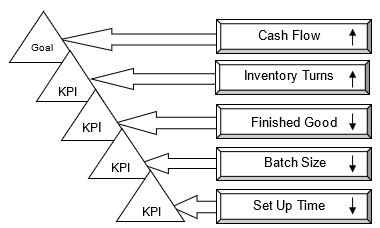As you develop your Lean Game Plan, you’ll identify KPI’s–Key Performance Indicators that you want to affect with your Lean improvements. Often you need to go several layers deep before you get to the actual kaizen event. This blog will explain how to match your kaizen’s to KPIs successfully.

Let’s use the picture above as an example. The overall goal for this company is to increase cash flow. We can increase cash flow in several ways, but one of the easiest ways is to reduce the amount of inventory kept on hand. Our main KPI is to improve cash flow.
A KPI to support that is measuring Inventory turns. We want to increase the inventory turns for our company. Increasing turns means we keep less cash tied up in inventory. What impacts the inventory turn KPI? Raw, WIP, and Finished goods.
In this example, we are measuring finished goods because it is the most expensive, least flexible form of inventory. If we can reduce our Finished Goods our inventory turns will increase. Assuming we don’t bring in more raw material and generate more WIP.
How do impact our WIP and Finished goods? Generating smaller batch sizes can help. This impacts WIP most of all. Let’s say you build your product in batches of 200 like one company I worked with did.
That means that your manufacturing space, material handling, WIP space all are based on holding 200 units. Besides the fact this increases your space requirements, it explodes the WIP kept on the floor increasing your inventory turns.
Now, if you install a flow line and produce units in batches of one, what happens to your space requirements and WIP? They go down! In this example, the batch size used to produce your product drives your WIP and affects your finished goods. This drives up your inventory.
To reduce your inventory, reduce your batch size. Often you can’t just reduce your batch size. Maybe you use parts from a machining center that has a four-hour setup time. This limits how often you want to set up the machine to run these parts.
It makes little sense to spend four hours setting up and run 25 parts. Unless you are a machine shop, it will be hard to stay in business doing that. Now we have identified where the kaizen activity needs to occur.
We need to use setup reduction or SMED techniques to reduce the setup time. Cutting setup time in half is possible in most cases after one setup reduction kaizen event. If you can drive your setup times into minutes, the goal of SMED- Single Minute Exchange of Die- then you can produce smaller batches.
Smaller batches lead to less WIP and Finished goods which increases inventory turns and improves your cash flow! While increasing cash flow is a simple statement to make, conducting the kaizen event that will make that happen is many layers of KPI’s away. Make sure as you develop your kaizen schedules, you match your Kaizen’s to KPIs.
It is an honor to serve you, and I hope that you and your company are getting better every day!
Follow me on Twitter
Join me on LinkedIn
Listen to the podcast here
